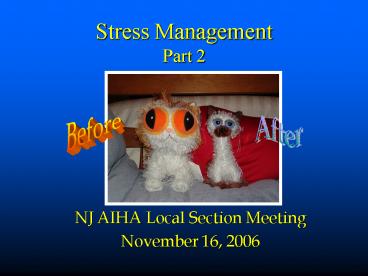Stress Management Part 2 PowerPoint PPT Presentation
1 / 16
Title: Stress Management Part 2
1
Stress ManagementPart 2
Before
After
- NJ AIHA Local Section Meeting
- November 16, 2006
2
Review
- Stress
- is the automatic biochemical state that
results when the body is required to respond
to a physical or psychological demand. - may be caused by pleasant or unpleasant
perceptions. - may have positive or negative effects.
(Eustress, Neustress, Distress)
3
Review
Adrenaline
The stress response is driven by hormones
(chemicals) flowing throughout the body. They
control blood flow, heart rate, glucose levels,
and the overall readiness of the body for
physical action. Stress hormones are produced
automatically by the endocrine system in response
to the level of urgency the brain perceives.
Corticol
Noradrenaline
Thyroxine
Triiodothionine
4
Hormone
- Definition
5
ExampleAdrenaline (Epinephrine)
- Epinephrine(an intravenous drug)
- Stimulates cardiac action during cardiac
arrest. - Causes vasoconstriction for treating
anaphylactic shock and sepsis. - Acts as a bronchodilator for treating acute
asthma.
- Adverse side effects include
- Palpitations
- Tachycardia
- Arrhythmia
- Anxiety
- Headache
- Tremor
???
6
Chemical Half Life
The instantaneous concentration (Ct) of a
chemical such as adrenaline in the body follows
the mathematical laws of exponential decay. The
half life of adrenaline is about 2 minutes.
7
Review
The brain is composed of three basic sections
i.e., the triune concept. Brain researchers
believe that the three parts evolved
independently over the course of human
development. The most ancient structure, the
R-complex is common among all vertebrates today
and controls basic body functions. The limbic
and neomammalian sections appeared more recently
in evolution and control higher functions.
8
The Human Brain
It Is What it Is!
Research
also shows that the
three segments are inter-
connected but operate
within
pre-programmed levels of
independence. And for some
functions,
the cerebrum simply
cannot override neurological commands
originating in these lower segments. So, when
crisis conditions prevail, these systems operate
almost autonomously, directing the basic human
functioning toward survival-based reaction.
9
Out of Control
10
Emotions of the Stress Response
- The two emotions specifically associated with
the stress response are - fear and
- anger
- The science of EvolutionaryPsychology
hypothesizes thatstress emotions are
survivalmechanisms which evolvedmuch the same
way that ourphysical characteristics did. Their
presence in any prehistoric individual ensured a
longer life expectancy and greater reproductive
success.
11
What is Fear?
- Fear is the unpleasant feeling that arises as a
normal response to realistic danger.
- Isaac Marks, Psychologist (1987)Fear is a vital
evolutionary legacy that leads an organism to
avoid threat, and has obvious survival value. It
is an emotion produced by the perception of
present or impending danger and is normal in
appropriate situations. Without fear, few would
survive long under natural conditions.
12
Excessive FearThe Adaptive Conservatism
Hypothesis
- Isaac Marks also believed that the excessive
anxiety that some people experience may be an
evolved tendency to be extra cautious.
- In the terms of our ancestors genetic survival,
the cost of mistakenly assuming that something
was safe, when in fact it was dangerous, would
have been much higher than the cost of erring on
the safe side and assuming it was dangerous, even
if it was not.
13
What is Anger?
- Anger is also hypothesized to have evolved as a
solution to basic survival needs. Anger focuses
attention on a perceived threat and prepares an
individual to mount a defensive (or aggressive)
physical response. Potential threats may
include ones personal safety, safety of family,
and competition for resources.
14
Regarding Resources
Abraham Maslows theory of motivation suggests
that humans operate on a hierarchy of needs that
influences their behavior.
15
Excessive Anger?
- An Hypothesis
- Our society today is fast-paced and most of our
primary needs have been satisfied. Consistent
with Maslows hierarchy, we may have become
preoccupied with satisfying the needs of - Self Actualization
- Esteem and Respect
16
Stress-Prone Personality Types
- Type A
- Excessive time urgency
- Domineering
- Hostile
- Hyperaggressive
- Codependent
- Insecure
- Self sacrificing
- Perfectionists
- Helpless-hopeless
- Type R
- sensation seeker
- Hardy

